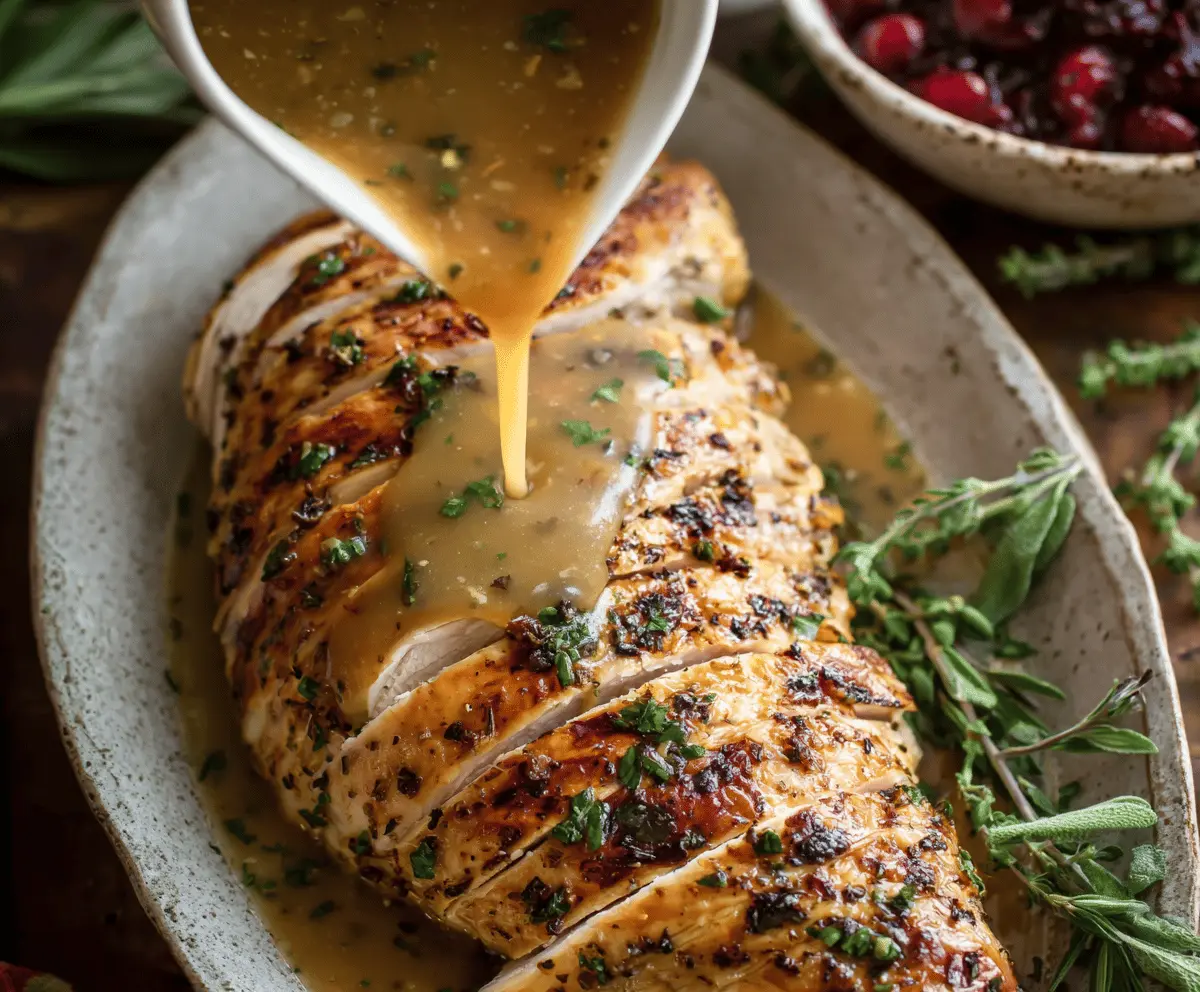Brown Butter Herb Turkey Gravy is a rich and flavorful twist on the classic turkey gravy we all know and love. The nutty brown butter adds a deep, toasty flavor, while fresh herbs bring a lovely aroma and brightness that really lifts the whole dish. It’s smooth, comforting, and perfect for drizzling over turkey, mashed potatoes, or even stuffing.
I love how easy this gravy comes together but it tastes like you’ve spent hours in the kitchen. I usually make a batch right after roasting the turkey, using the pan drippings and adding some chopped fresh herbs like rosemary and thyme for that extra pop of flavor. The brown butter step is my favorite—it gives the gravy a cozy, homey vibe that makes everyone at the table smile.
One of my favorite ways to enjoy this gravy is with classic Thanksgiving sides, but honestly, I could pour it over just about anything. It’s those little touches—the warm butter, the fresh herbs—that make a simple meal feel special. If you want a gravy that feels homemade and heartwarming, this one’s definitely worth a try!
Key Ingredients & Substitutions
Butter: Unsalted butter is best here so you control the salt. Browning it creates a nutty flavor that makes the gravy special. If you want a dairy-free version, try a vegan butter or olive oil, but the flavor will change.
Flour: All-purpose flour thickens the gravy smoothly. For a gluten-free option, cornstarch or arrowroot powder works, but add it slowly and stir well to avoid lumps.
Turkey drippings/stock: The drippings bring deep turkey flavor. If you don’t have drippings, use good-quality turkey or chicken stock. Avoid water as it lacks flavor.
Fresh herbs: Rosemary, thyme, and sage add lovely earthiness. If fresh isn’t available, dried herbs work too—use less, about one-third the fresh amount, since dried herbs are stronger.
White wine: Adds acidity and depth, but it’s optional. If you skip it, just add a bit more stock instead.
How Do You Make Perfect Brown Butter Without Burning It?
Brown butter is key to the rich flavor here, but it can easily burn. Here’s how I nail it every time:
- Use a light-colored pan so you can watch the color change easily.
- Melt butter over medium heat.
- Stir often as it melts and starts to foam.
- Watch for tiny brown bits forming at the bottom and a toasty smell—this is your cue to remove from heat.
- If it smells burnt or looks very dark brown, start over because burnt butter tastes bitter.
Once browned, quickly add the flour to keep it cooking evenly and avoid burning. This step adds a deep, nutty background flavor that makes your gravy stand out.
Equipment You’ll Need
- Medium saucepan – perfect size for making the gravy without splashing.
- Whisk – helps keep the gravy smooth and lump-free when adding flour and liquids.
- Heatproof spoon or spatula – useful for scraping up browned bits and stirring.
- Measuring cups and spoons – to measure butter, flour, and liquids accurately.
Flavor Variations & Add-Ins
- Add a splash of heavy cream for a richer, creamier gravy that’s extra comforting.
- Stir in finely chopped sautéed mushrooms to add earthiness and texture.
- Swap fresh herbs with dried Italian seasoning if you want a simpler herb mix.
- Mix in a teaspoon of Dijon mustard for a subtle tang and depth of flavor.

How to Make Brown Butter Herb Turkey Gravy
Ingredients You’ll Need:
- 4 tablespoons unsalted butter
- 3 tablespoons all-purpose flour
- 2 cups turkey drippings or stock (from roasted turkey pan or store-bought turkey broth)
- ½ cup dry white wine or extra turkey stock (optional)
- 1 tablespoon fresh rosemary, finely chopped
- 1 tablespoon fresh thyme leaves
- 1 teaspoon fresh sage, finely chopped
- Salt and freshly ground black pepper, to taste
How Much Time Will You Need?
This gravy takes about 15 minutes to prepare. Most of the time is spent carefully browning the butter and slowly simmering the gravy until it thickens to perfection. It’s a quick addition that adds a big flavor boost to your turkey dinner!
Step-by-Step Instructions:
1. Gather Your Pan Drippings:
After roasting your turkey, pour the pan drippings into a measuring cup or bowl. Let it rest for a few minutes so the fat separates from the juices. Then, skim off about 4 tablespoons of fat to use for the gravy, reserving the rest of the drippings. You want about 2 cups of liquid total for this recipe—use stock to top up if needed.
2. Make the Brown Butter Roux:
In a medium saucepan over medium heat, melt the butter. Keep stirring it as it cooks until it turns a golden brown color and smells nutty—this usually takes 4-5 minutes. Be careful not to let it burn. Once browned, whisk in the flour and continue whisking until you get a smooth paste. Cook this roux for 2-3 minutes until it has a light golden color and the raw flour taste is gone.
3. Add the Liquid and Herbs:
Slowly whisk in the turkey drippings and stock, stirring constantly so there are no lumps. Bring it to a gentle simmer. If you’re using white wine, add it now, then stir in the fresh rosemary, thyme, and sage. Let everything simmer together for about 5-7 minutes, stirring occasionally, until the gravy thickens to your liking.
4. Season and Serve:
Taste the gravy and add salt and freshly ground black pepper as you like. Serve the warm brown butter herb turkey gravy over your sliced turkey and enjoy that rich, herby goodness on every bite.
Can I Use Store-Bought Turkey Stock Instead of Pan Drippings?
Yes, you can use store-bought turkey or chicken stock if you don’t have pan drippings. Just use about 2 cups total and consider adding a little butter for extra richness to mimic the drippings’ flavor.
How Do I Thicken My Gravy if It’s Too Thin?
If your gravy is too thin, whisk together a small amount of flour or cornstarch with cold water to make a slurry, then slowly add it to the simmering gravy while stirring until it reaches the desired thickness.
Can I Make This Gravy Ahead of Time?
Absolutely! You can make the gravy up to two days ahead and store it in the fridge. Reheat gently on the stove, stirring occasionally, and add a splash of stock or water if it thickens too much.
What If I Don’t Have Fresh Herbs?
Feel free to substitute with dried herbs, using about one-third the amount since dried herbs are more concentrated. Add them earlier in the cooking process to let their flavors develop.
